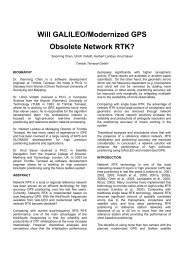GPS Integrity and Potential Impact on Aviation Safety - intelligent ...
GPS Integrity and Potential Impact on Aviation Safety - intelligent ...
GPS Integrity and Potential Impact on Aviation Safety - intelligent ...
Create successful ePaper yourself
Turn your PDF publications into a flip-book with our unique Google optimized e-Paper software.
NO. 1 <str<strong>on</strong>g>GPS</str<strong>on</strong>g> AND AVIATION SAFETY 63<br />
5. <str<strong>on</strong>g>GPS</str<strong>on</strong>g> MODERNISATION AND INTEGRITY MONITORING.<br />
<str<strong>on</strong>g>GPS</str<strong>on</strong>g> achieved full operati<strong>on</strong>al capability (FOC) <strong>on</strong> 17 July 1995 with 24 operati<strong>on</strong>al<br />
satellites (US DoD, 2000). For many applicati<strong>on</strong>s <str<strong>on</strong>g>GPS</str<strong>on</strong>g> delivers a widely accepted<br />
service with performance levels that often meet the requirements for the particular<br />
applicati<strong>on</strong>. However, as has been shown in previous secti<strong>on</strong>s, for other requirements<br />
including high integrity safety-of-life critical applicati<strong>on</strong>s such as aviati<strong>on</strong>, the<br />
current system does not provide the required navigati<strong>on</strong> performance (RNP). Because<br />
of the huge potential market for satellite navigati<strong>on</strong> services, the end of the cold<br />
war, developments in satellite navigati<strong>on</strong> systems in other parts of the world, <str<strong>on</strong>g>and</str<strong>on</strong>g><br />
technological developments in security related areas, the US government has put in<br />
place initiatives aimed at enhancing the performance of the system whilst still maintaining<br />
its crucial military role. Since 1996, several official announcements have been<br />
made in support of this including the Accuracy Improvement Initiative (AII) <str<strong>on</strong>g>and</str<strong>on</strong>g><br />
the <str<strong>on</strong>g>GPS</str<strong>on</strong>g> III programme. The objective of the <str<strong>on</strong>g>GPS</str<strong>on</strong>g> III initiative is to deliver a <str<strong>on</strong>g>GPS</str<strong>on</strong>g><br />
architecture that will satisfy current <str<strong>on</strong>g>and</str<strong>on</strong>g> evolving civilian needs, in particular the RNP<br />
for air navigati<strong>on</strong>. It will preserve <str<strong>on</strong>g>and</str<strong>on</strong>g> build <strong>on</strong> the successes of <str<strong>on</strong>g>GPS</str<strong>on</strong>g> by creating<br />
a new architecture based <strong>on</strong> defined operati<strong>on</strong>al requirements (Lee et al., 2001). The<br />
system will deliver enhanced positi<strong>on</strong>, velocity, <str<strong>on</strong>g>and</str<strong>on</strong>g> timing (PVT) signals, <str<strong>on</strong>g>and</str<strong>on</strong>g> related<br />
services to meet the requirements of the next generati<strong>on</strong> of military <str<strong>on</strong>g>and</str<strong>on</strong>g> civil<br />
<str<strong>on</strong>g>GPS</str<strong>on</strong>g> users. The first <str<strong>on</strong>g>GPS</str<strong>on</strong>g> III satellite is to be launched in 2009, with an eventual<br />
30-satellite c<strong>on</strong>stellati<strong>on</strong> to serve users until around 2030 (Lee et al., 2001). FOC<br />
is expected around 2020. The program is currently in the requirements definiti<strong>on</strong><br />
<str<strong>on</strong>g>and</str<strong>on</strong>g> preliminary design phases.<br />
In the short term, the system level integrity provisi<strong>on</strong> will benefit from better internal<br />
(built-in) self checks mainly through more robust algorithms <str<strong>on</strong>g>and</str<strong>on</strong>g> the use of more<br />
tracking data from an enhanced tracking network of ground stati<strong>on</strong>s. No external<br />
(independent) m<strong>on</strong>itoring is proposed. User level m<strong>on</strong>itoring <str<strong>on</strong>g>and</str<strong>on</strong>g> quantified RAIM<br />
availability analysis have shown that, even though a certain amount of improvement is<br />
to be expected, it will not be significant compared to the current performance. In the<br />
l<strong>on</strong>g term, a key element of the proposed <str<strong>on</strong>g>GPS</str<strong>on</strong>g> III programme is to address the RNP<br />
for aviati<strong>on</strong> <str<strong>on</strong>g>and</str<strong>on</strong>g> how this is to be achieved, particularly the integrity requirements.<br />
The expectati<strong>on</strong> is that the system will incorporate an independent external network<br />
to m<strong>on</strong>itor the signal-in-space (SIS) <str<strong>on</strong>g>and</str<strong>on</strong>g> notify users of any significant anomaly<br />
with the required time-to-alerts <str<strong>on</strong>g>and</str<strong>on</strong>g> within the specified probabilities of risk. For safety<br />
reas<strong>on</strong>s, it would still be necessary to have a RAIM capability within the receiver<br />
to protect against some of the anomalies, which may not be captured by the external<br />
network.<br />
6. <str<strong>on</strong>g>GPS</str<strong>on</strong>g> AUGMENTATION AND INTEGRITY MONITORING.<br />
There are various augmentati<strong>on</strong> mechanisms that could be used to support the integrity<br />
requirements for civil aviati<strong>on</strong>. GNSS1 based approaches include satellitebased<br />
augmentati<strong>on</strong> system (SBAS), ground-based augmentati<strong>on</strong> system (GBAS)<br />
<str<strong>on</strong>g>and</str<strong>on</strong>g> aircraft based augmentati<strong>on</strong> system (ABAS). SBAS <str<strong>on</strong>g>and</str<strong>on</strong>g> GBAS systems should<br />
enable precisi<strong>on</strong> approach <str<strong>on</strong>g>and</str<strong>on</strong>g> l<str<strong>on</strong>g>and</str<strong>on</strong>g>ing to be achieved. With respect to ABAS, the<br />
integrati<strong>on</strong> of <str<strong>on</strong>g>GPS</str<strong>on</strong>g> with barometric aiding has the potential to achieve the integrity<br />
requirements for oceanic <str<strong>on</strong>g>and</str<strong>on</strong>g> en-route phases of flight. <str<strong>on</strong>g>GPS</str<strong>on</strong>g> <str<strong>on</strong>g>and</str<strong>on</strong>g> INS integrati<strong>on</strong><br />
appears to have the potential to satisfy the required navigati<strong>on</strong> performance for<br />
up to n<strong>on</strong>-precisi<strong>on</strong> approach phase of flight. However, so far research <strong>on</strong> this has



